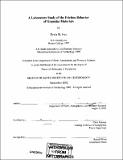| dc.contributor.advisor | Chris Marone. | en_US |
| dc.contributor.author | Frye, Kevin M. (Kevin Michael), 1972- | en_US |
| dc.contributor.other | Massachusetts Institute of Technology. Dept. of Earth, Atmospheric, and Planetary Sciences. | en_US |
| dc.date.accessioned | 2005-08-24T22:04:03Z | |
| dc.date.available | 2005-08-24T22:04:03Z | |
| dc.date.copyright | 2002 | en_US |
| dc.date.issued | 2002 | en_US |
| dc.identifier.uri | http://hdl.handle.net/1721.1/8013 | |
| dc.description | Thesis (Ph. D.)--Massachusetts Institute of Technology, Dept. of Earth, Atmospheric, and Planetary Sciences, 2002. | en_US |
| dc.description | Includes bibliographical references. | en_US |
| dc.description.abstract | I report on laboratory experiments designed to investigate the microphysical processes that result in rate- and state-dependent friction behavior and experiments designed to match the boundary conditions used by numerical models of granular friction. The effect of relative humidity (RH from <5% to 100%) is investigated with velocity stepping tests (10-20 tm/s) and slide-hold-slide (SHS) tests (3-1000 s) on 3 mm thick layers of quartz powder, alumina powder, Westerly granite powder, and Westerly granite blocks sheared at 25 MPa normal stress. Powders are conditioned in situ under controlled RH to create new surface area before shearing. A transition from velocity-strengthening to velocity-weakening frictional behavior occurs as RH increases. Frictional healing is negligible at low humidity and increases with increasing RH for both materials. While the coefficient of sliding friction for powders is independent of humidity, bare surface data indicate that sliding friction decreases with increased RH. Normal stress vibrations in SHS tests can add compaction induced granular strengthening, but for constant normal force tests, chemically assisted healing mechanisms control the friction behavior. The chemically assisted contact junction processes can be reduced or turned off at low humidity at room temperature in quartz and alumina. Velocity stepping tests and SHS tests are also performed at different values of applied normal stress (5 to 45 MPa) after pre-conditioning at high normal stress (40 and 35 MPa) for powders and no pre-conditioning for bare surfaces. Time-dependent frictional healing decreases with increasing normal stress. | en_US |
| dc.description.abstract | (cont.) For the powders, velocity stepping tests require the use of a 2 state variable model to accurately retrieve rate- and state-friction parameters. The complex velocity dependent behavior may be a result of over-compaction in the granular layers during preconditioning. Numerical models of granular shear show lower friction and a greater tendency for stick slip than laboratory studies designed to investigate fault mechanics. Chapters 4 and 5 detail laboratory experiments designed to reproduce the conditions of numerical models and test the role that grain characteristics play in controlling frictional behavior. Friction and microstructural data are compared for direct shear experiments on thin layers (2-3 mm) of angular quartz sand and spherical glass beads. We study the effect of grain shape, roughness, size distribution,comminution, and particle dimensionality In a non-fracture loading regime, sliding friction for In a non-fracture loading regime, sliding friction for smooth spherical particles ([mu] [approx. equal to] 0.45) is measurably lower than for angular particles ([mu] [approx. equal to] 0.6). Anarrow particle size distribution (PSD) of spherical beads (105-149 [mu] tm) exhibits unstable stick-slip behavior, whereas a wide PSD of spheres (1-800 [mu]m) and the angular gouge display stable sliding. At higher stress, where grain fracture is promoted, initially spherical particles become stable with accumulated slip and friction increases to the level observed for angular gouge. Quartz glass rods are sheared in 1-D and 2-D configurations and I compare the results to previously published numerical models and to the friction behavior of angular gouge. | en_US |
| dc.description.statementofresponsibility | by Kevin M. Frye. | en_US |
| dc.format.extent | 145 leaves | en_US |
| dc.format.extent | 10401799 bytes | |
| dc.format.extent | 10401555 bytes | |
| dc.format.mimetype | application/pdf | |
| dc.format.mimetype | application/pdf | |
| dc.language.iso | eng | en_US |
| dc.publisher | Massachusetts Institute of Technology | en_US |
| dc.rights | M.I.T. theses are protected by copyright. They may be viewed from this source for any purpose, but reproduction or distribution in any format is prohibited without written permission. See provided URL for inquiries about permission. | en_US |
| dc.rights.uri | http://dspace.mit.edu/handle/1721.1/7582 | |
| dc.subject | Earth, Atmospheric, and Planetary Sciences. | en_US |
| dc.title | A laboratory study of the friction behavior of granular materials | en_US |
| dc.type | Thesis | en_US |
| dc.description.degree | Ph.D. | en_US |
| dc.contributor.department | Massachusetts Institute of Technology. Department of Earth, Atmospheric, and Planetary Sciences | |
| dc.identifier.oclc | 52076374 | en_US |
